Simplifying Synergy Sets
06/16/2024
Modern Horizons sets have historically been bangers to draft. I remember both MH1 and MH2 being widely-loved limited sets, with MH2 especially sticking out as a set that just kept coming back to MTGO by popular demand.
One of the big reasons why they're so fun is that the design parameters of the set allow R&D to be a lot more adventurous than in most other sets. Many old mechanics are reused in interesting and new ways (I think MH3 has something like 40 different mechanics in it); cards get a lot more complexity budget than normal; and the power level is just overall higher than normal sets.
In these respects, MH3 is no different.
Two of its flagship mechanics are Eldrazi and Energy - both inherently extremely parasitic mechanics. Most Eldrazi cards synergize with Eldrazi and not much else; and the same is true of most energy cards. Both of these packages benefit a lot from being built into extremely deeply and specifically, and are much less powerful when just played as individual cards or even as a small package.
Because of these parasitic mechanics, MH3 is one of the most synergistic sets we've seen - you're heavily incentivized to play a high synergy deck, instead of just a pile of good cards. So how should that change your drafting and deckbuilding?
Part 1: Play the Power
One maxim I enjoy saying in limited, whether sealed or draft, is: "play the good cards, not the bad cards".
This is, of course, intentionally reductive and hyperbolic, and not meant to be useful so much as glib. Cards are much more complex than just being reduced to "good" or "bad", and exist in many context that can bring out their strengths or weaknesses. But it gets at a small nugget of truth: in limited, you want to focus on cards that will give your deck more power.
In most sets, this involves playing singularly powerful cards. Rares like
Dream Trawler or Bonny Pall, Clearcutter; uncommons like Imodane's Recruiter or Slickshot Lockpicker; and premium commons like Inspiring Overseer or Writhing Chrysalis.Of course, some cards will be somewhat conditional in their strength.
Goblin Tomb Raider is a great example of this: it was a fairly strong common in its format when built around, but if you couldn't consistently make it a 2/2 haste then it was very mediocre.But in most sets, the majority of power comes from generically strong cards with maybe some minimal synergies. You will still want a focused deck, but often the direction that bombs will provide are much more in terms of colors than anything else.
However, most is not all.
Power Through Synergy
In a highly synergistic set like MH3, there will be much more power allocated to specific buildarounds, and less to generically strong rate-monster cards. Instead of the strongest rares being like Dream Trawlers, more of them are cards like
Echoes of Eternity and Aether Revolt. Instead of Imodane's Recruiters, there are cards like Essence Reliquary.Of course, MH3 still has its fair share of strong rate cards - like
Guide of Souls and Writhing Chrysalis. But even those cards reward you for maximizing them - Guide of Souls is a lot scarier when you follow it up with a Hexgold Slith than when you follow it up with a Nyxborn Unicorn; and Writhing Chrysalis goes from solid to unbeatable when you follow it up with ramping into a 7 mana play, or when you have other sources and uses for spawns.So, the best decks in MH3 tend to be the ones that can maximize on synergy, not necessarily just the ones with the "best cards" so to speak.
You might think that this goes against the concept I expressed earlier about playing powerful cards. But at the end of the day, this isn't actually anything different, just recontextualized! We're still asking the same questions: How do you maximize the power of your limited deck? Where is the power in the set?
Part 2: Drafting Synergy
Drafting a synergy set isn't that much different than drafting other sets. It's still limited; you can still leverage draft fundamentals. But synergy sets do have some things you should keep in mind.
Focus on Synergy Early
When to take a buildaround is always an interesting question. Taking one early makes it easier to fully build your entire deck around the card, but risks just not seeing the cards to do so and trainwrecking with no other avenue to pivot onto; on the other hand waiting until late to pick up buildarounds runs the risk of just not being able to leverage them anymore, as their demands might be hard to meet with fewer picks left in the draft.
In answering this question, the strength and feasibility of the buildaround in question are very important things to consider. The stronger a buildaround is, the more enticing it is to take at any point, as the payoff is higher. The easier a card is to build around, the more willing you should be to take it late, as it becomes easier to slot it into your deck without needing to find many specific cards.
Part of the reason MH3 is so synergistic is that it has a lot of strong and easy-to-build-around synergy cards. There's tons and tons of support for all the main archetypes, and even lots of support for more niche synergies like Essence Reliquary decks or the UB draw 3 archetype.
Because of this, you often really want to be finding a synergy lane! Since the payoffs are strong and fairly likely to work if you try, aggressively pursuing buildarounds ends up providing big rewards for not much risk.
And because so many of the mechanics in MH3 specifically are quite parasitic, this especially incentivizes going in early! The earlier you can start going down a synergistic path, the more cards along that path you'll be able to get. And if you're playing Eldrazi or Energy, you're going to want as many of those cards as you can get your hands on.
Flexibility
Okay, but what if you don't see any strong synergy cards early to help define your path through the draft? There are many packs in this set that have quite a few solid synergy suppport pieces, but nothing that actually functions as a draw towards any direction. What do you pick then?
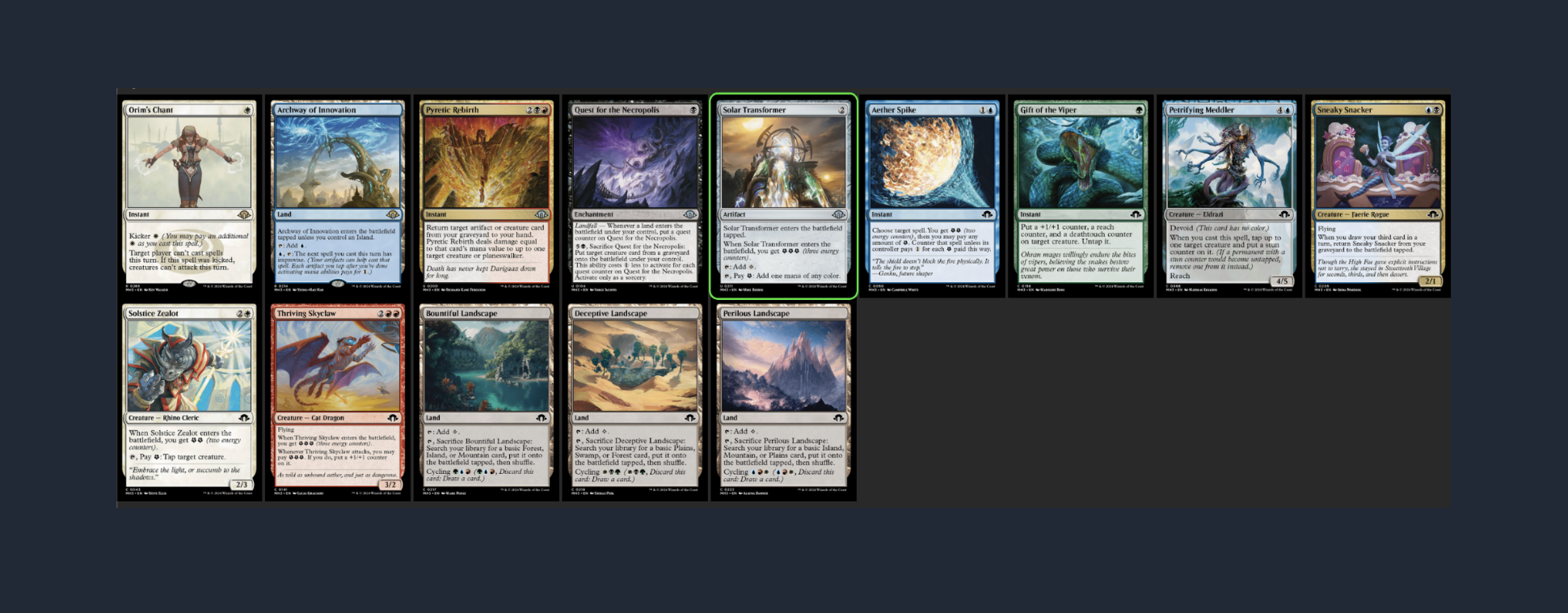
an example of a pack with not much synergy - so I take a flexible support piece here with Solar Transformer, and would take a land if the Transformer wasn't in the pack
Personally, I've been finding a lot of success in prioritizing flexibility in these spots. If you don't have a strong reason to go in any direction, then taking a card that can help you in multiple different directions is generally more appealing than one that might be above average if you end up in Energy but extremely mediocre otherwise.
This biggest examples here are lands: both MDFCs and Landscapes. They will just make any deck that plays them better, and you will want to pick some up at some point - so why not take them now, if you don't know what else you want? I'm fairly happy to first pick almost any land, if there's no strong direction in my pack.
Part of the reason for taking lands early is that there's just a lot of playables in this set. Almost every single card has some home - with exceptions mostly being cards printed specifically for constructed like the Medallions. It's not quite to the same degree as cube, but certainly runs in the same vein.
Between that and the existence of MDFCs, it's just not that hard to make enough playables for your deck even after taking many lands. After a certain point, you just can't fit more nonland cards in your deck - so taking additional nonlands only increases your deck's power by upgrading your worst card. And unless that's a big upgrade, it's probably not quite as impactful as upgrading a basic to either a MDFC or fixing land.
As an amusing anecdote/sidenote: I've had a couple drafts now where I took 8 or more lands pack 1, and looked very much like I was trainwrecking with very little in the way of playables or direction; but then was able to pretty easily find that direction in pack 2.
You can also take a card like
Malevolent Rumble, Nightshade Dryad, or Unfathomable Truths - specifically, one that is generically quite powerful and just nice support for a wide swath of decks. The point is simply to leave yourself open to be able to take advantage of any future paths that open up - as there definitely will be something to build around at some point.Part 3: Building Synergy
In some senses, drafting and building synergy decks are highly entangled. Since you need to pay close attention to how your synergies are shaping up during the draft, synergy decks even more than most need to be continuiously built during the draft, as opposed to being formed from a pile of cards at the end.
Deck Space
When you're building a highly synergistic deck - and especially when you're building one with parasitic elements like often happens in MH3 - deck space is something that you really have to pay attention to. Specifically, most synergies require you to dedicate some amount of space in your deck to cards that make that synergy work.
Eldrazi, for example, incentivizes you to put a lot of Eldrazi, colorless sources, and ramp in your deck. You want to have a lot of those three categories, which only leaves so much space for the rest of your deck - anything that doesn't fit in with your synergies will have to compete for the last few slots.
To put some numbers to this: let's say your deck has around 4ish ways to ramp (maybe two Malevolent Rumbles and two Nightshade Dryads), and then 12ish Eldrazi or Eldrazi payoffs. Then you have only about 7 more nonlands you can fit into your deck, or even fewer if you're playing more than 17 lands (perhaps with MDFCs). These 7 slots then probably want to include some removal - and suddenly you have only 3-4 slots left to play generically good cards that don't synergize.
So, maybe you can fit in some high-rate cards - maybe a copy of
Ral and the Implicit Maze, or a Serum Visionary - but it's going to be hard to play anything even close to middling. You just don't have room to.So, if you're going to build a high synergy deck - and you will want to often in this set - keep in mind that you just won't have much space for non-synergistic cards. Drafting something unrelated but powerful can still be correct, but there will be a lot more opportunities to make those picks - so you should strongly consider taking something structurally important to your deck instead.
As an aside: this deck space problem isn't unique to high synergy decks - in fact, one place it comes up all the time is with things like combat tricks! If you have a lot of combat tricks, equipment, or other cards in your deck that care about creatures without being creatures themselves, then you can quickly run out of deck space for any other noncreature spells. You want probably 15+ creatures, then have something like 4 tricks and 4 removal spells... and that's basically 23!
Sealed Synergy
In sealed, everything is about building. So you don't need to worry about prioritization the same way as in draft, but you do still need to figure out how to work with the tools you're given.
In most sealed formats, the big question is often what colors you're playing, and how much you're splashing. Which color combination lets you play the most powerful cards, and how much can you squeeze out of your pool through splashing?
But of course, in a high synergy format, figuring out which cards you have are most powerful in the first place is not trivial. Many of your powerful cards will scale their power based on how much support they have, and so you need to line that up with how much support your pool actually has for those to figure out the best space to build in.
Sometimes it'll be easy - sometimes your pool just gives you the best Eldrazi deck you've ever seen. Other times, it'll be extremely obvious that your pool has no way to support Eldrazi. But most of the time, you'll have several different directions that all have middling to good amounts of support. Then, you'll have to compare.
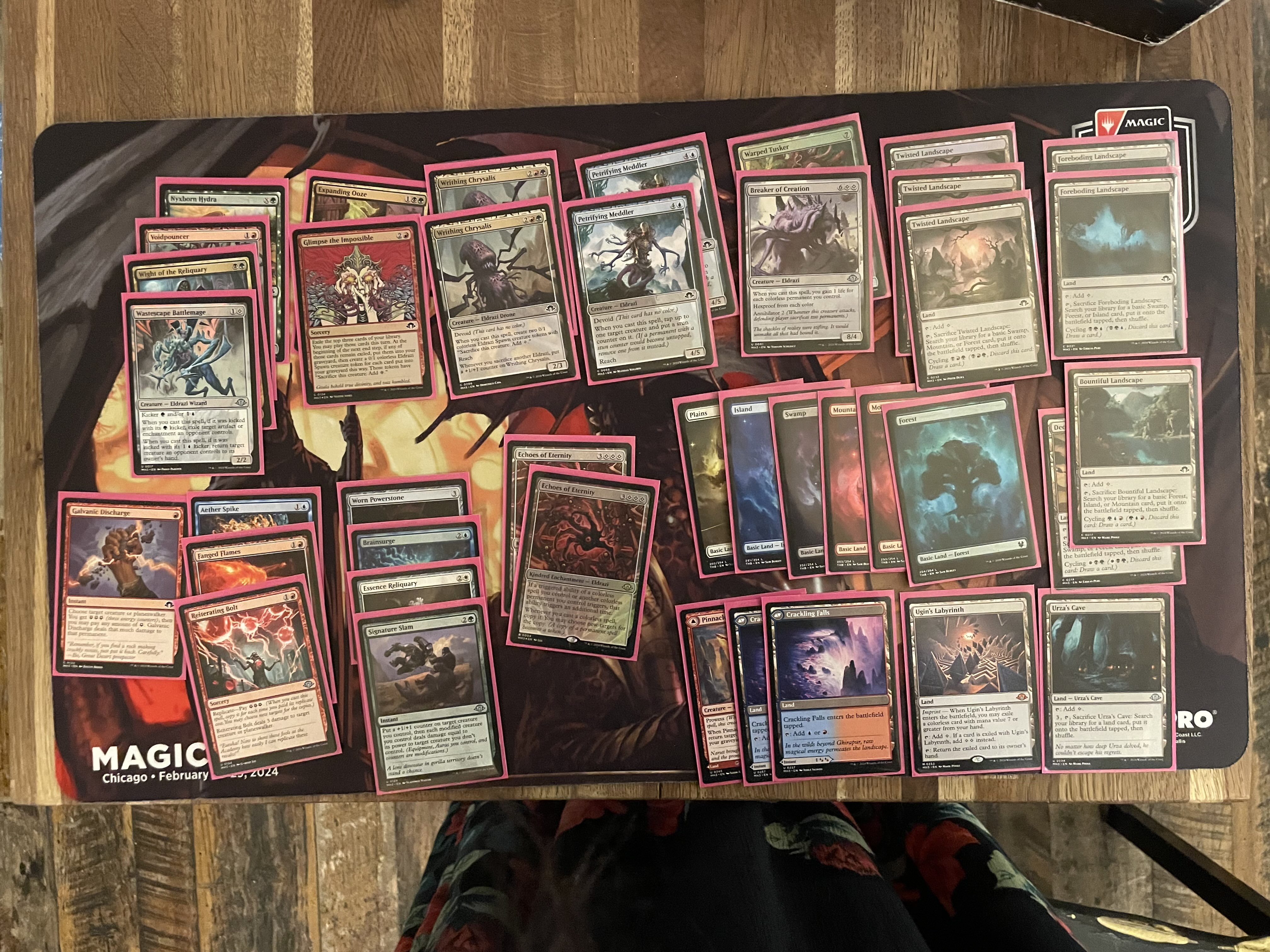
one of the best Eldrazi decks I've ever seen - aka my prerelease deck
So, what I'd suggest in building a sealed pool is to simply take all the potentially powerful cards in your pool, and for each one try to build a deck that maximizes it! It's hard to gauge exactly how good an all-in synergy deck will be, but certainly the first step is to actually try to visualize it.
And make sure to actually try everything! Some ideas might look good on paper, but then as you build you realize that maximizing the archetype in question means having an unplayable curve, or no removal, or a terrible manabase. Other builds might look awkward, but then as you start actively thinking about them you find more support than you expected, perhaps from places you wouldn't normally consider in a streamlined draft deck.
Conclusion
Fundamentally, limited in synergy sets is just like limited in any other set. You still want to focus on the same core things - where does the power in the draft and in your deck come from, and how can you make choices that maximize that power?
The difference is where and how that power manifests. The more synergy becomes important, the more you need to pay attention to your whole deck, and not just individual cards. Of course, this has always been an essential skill in all limited formats - synergy sets simply amplify that.
And that's one of the reasons I've been really enjoying MH3. I really enjoy building entire decks, instead of feeling like I just want to take the best individual cards over and over again. It's a more difficult way of drafting, but also much more rewarding when you do it right.
Addendum: MH3 Synergy Packages
I realized after publishing it that my article was a bit rushed, and could use with some more specific examples. So, here are a bunch of synergy packages in MH3, in image form. The lists of cards in them aren't fully extensive, and this also isn't an extensive list of all the synergy packages in the set - but hopefully this gives you an idea of the kinds and depths of synergy you can find in this set.
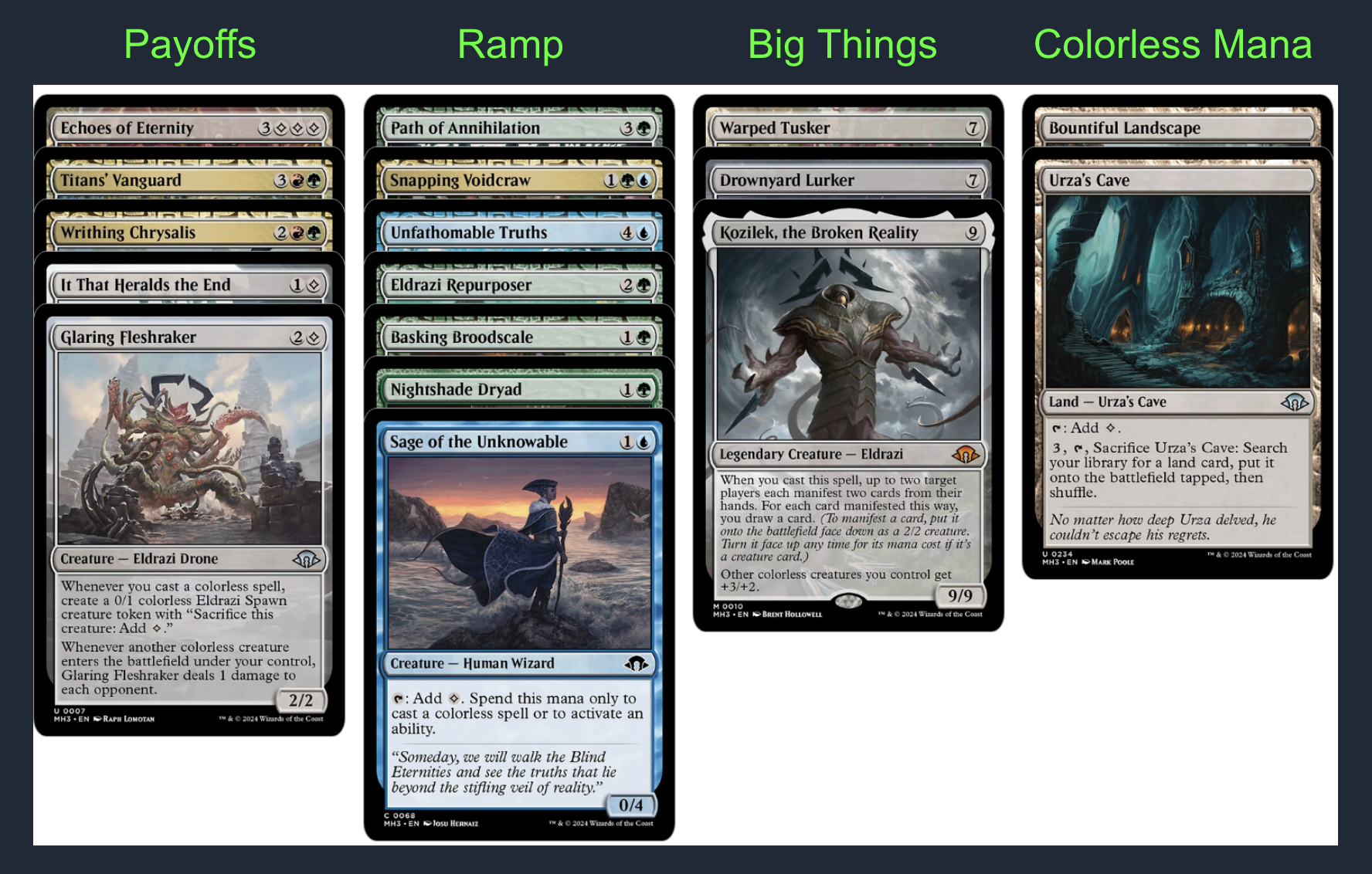
sometimes you play a lot of payoffs for being Eldrazi, other times you just ramp into big things
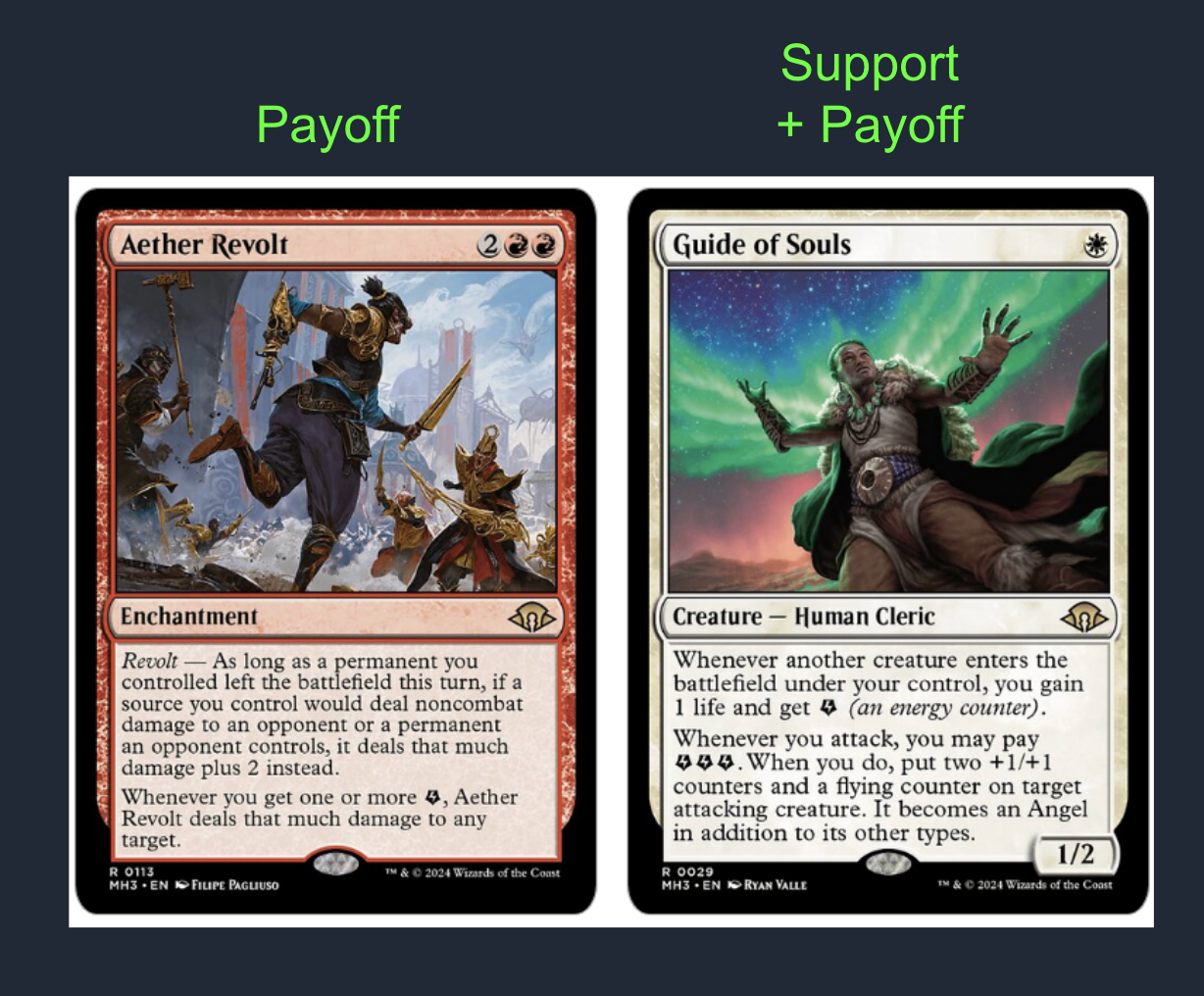
energy is mostly just pure parasitism - almost every card is both support and payoff, and you just want as many energy cards as you can get to payoff your best payoff. Aether Revolt is one of the only pure payoffs in the set, and is very good
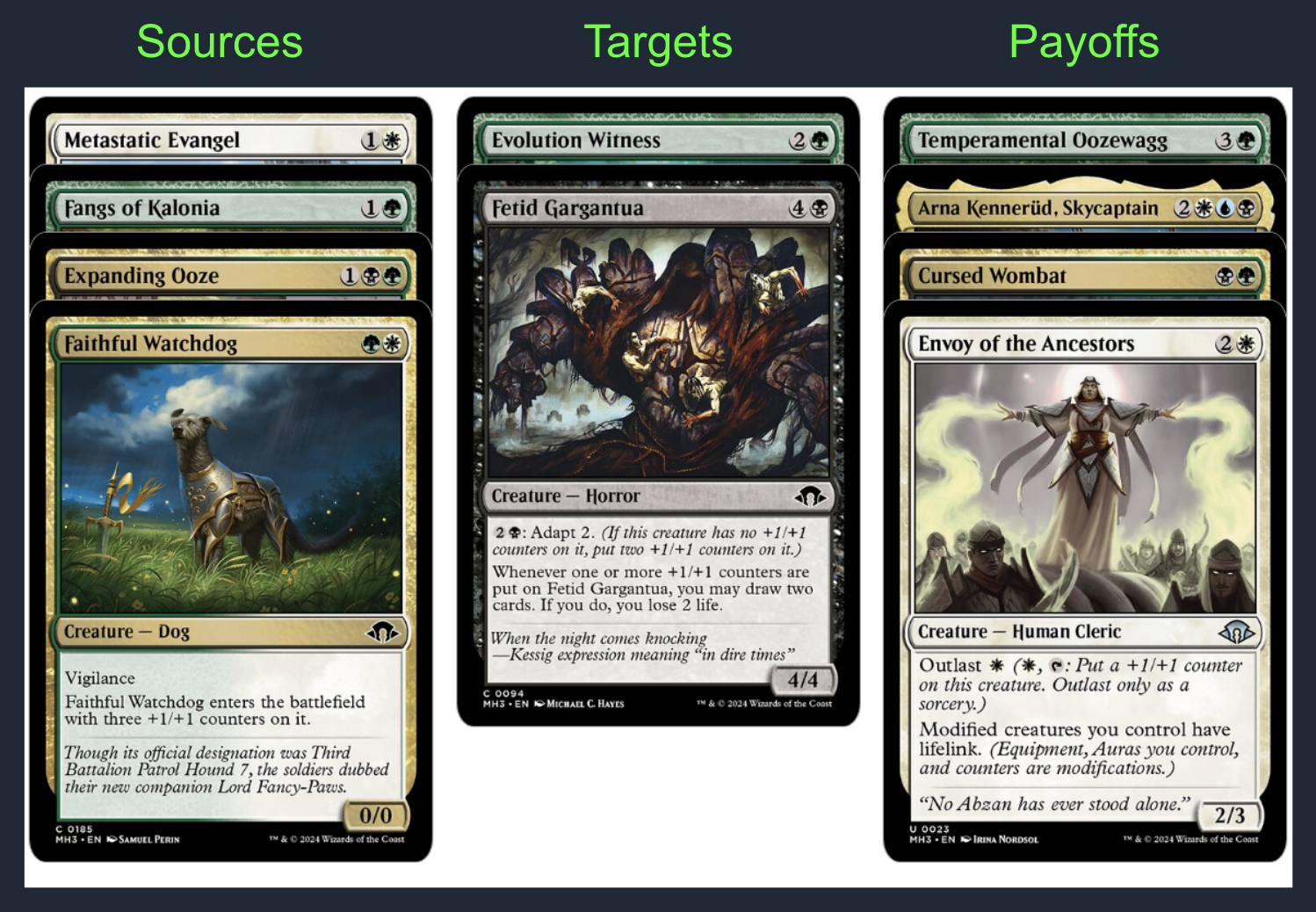
+1/+1 counter or modified synergies can simply take the form of oversized creatures, or can do silly things with cards like Evolution Witness that turn counters into value
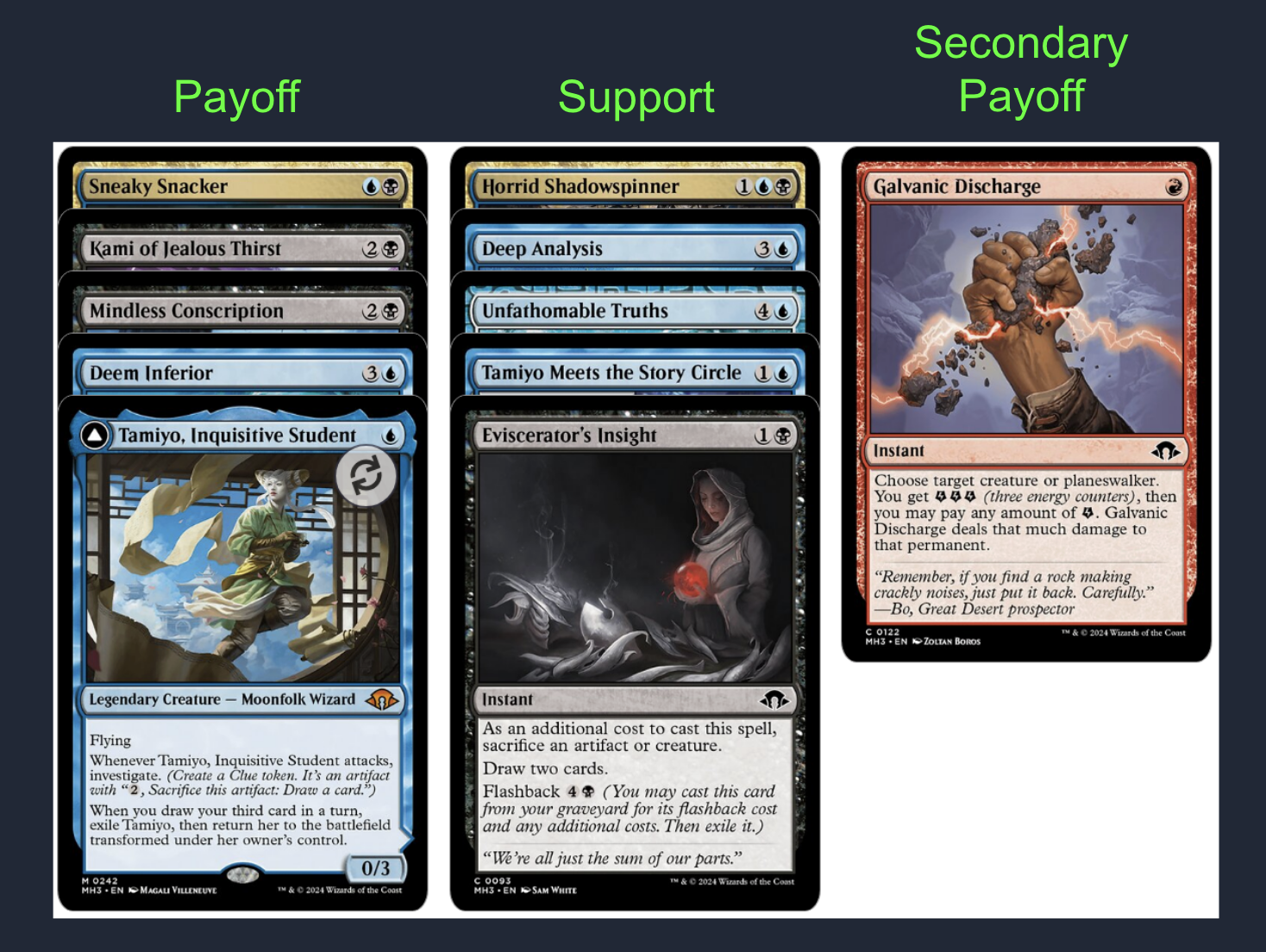
draw 3 has a bunch of explicit payoffs - especially watch out for Sneaky Snacker plus Eviscerator's Insight - but you can also just leverage your card draw to be a control deck with cheap removal
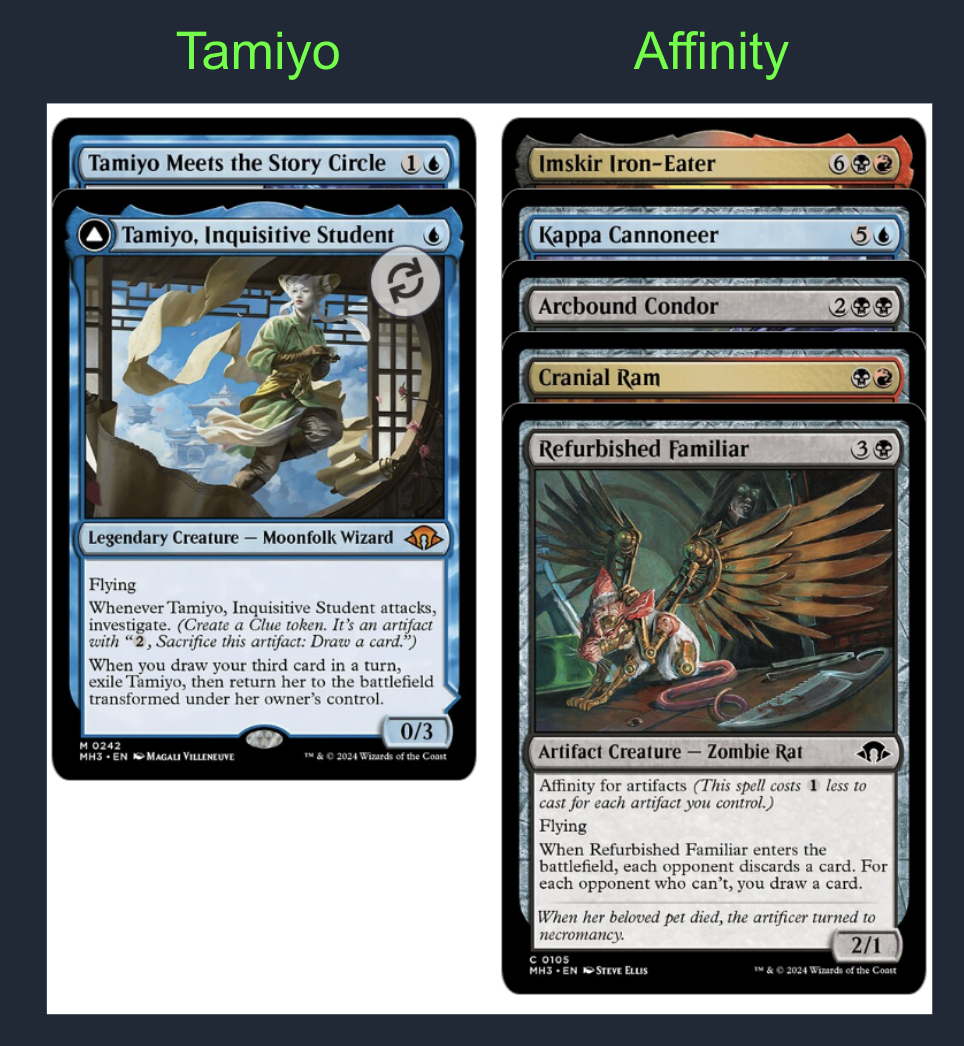
the artifact deck is hard to make work, but one way to supercharge it is through the two Tamiyo cards, which both make an unhinged number of artifacts to power out your synergies
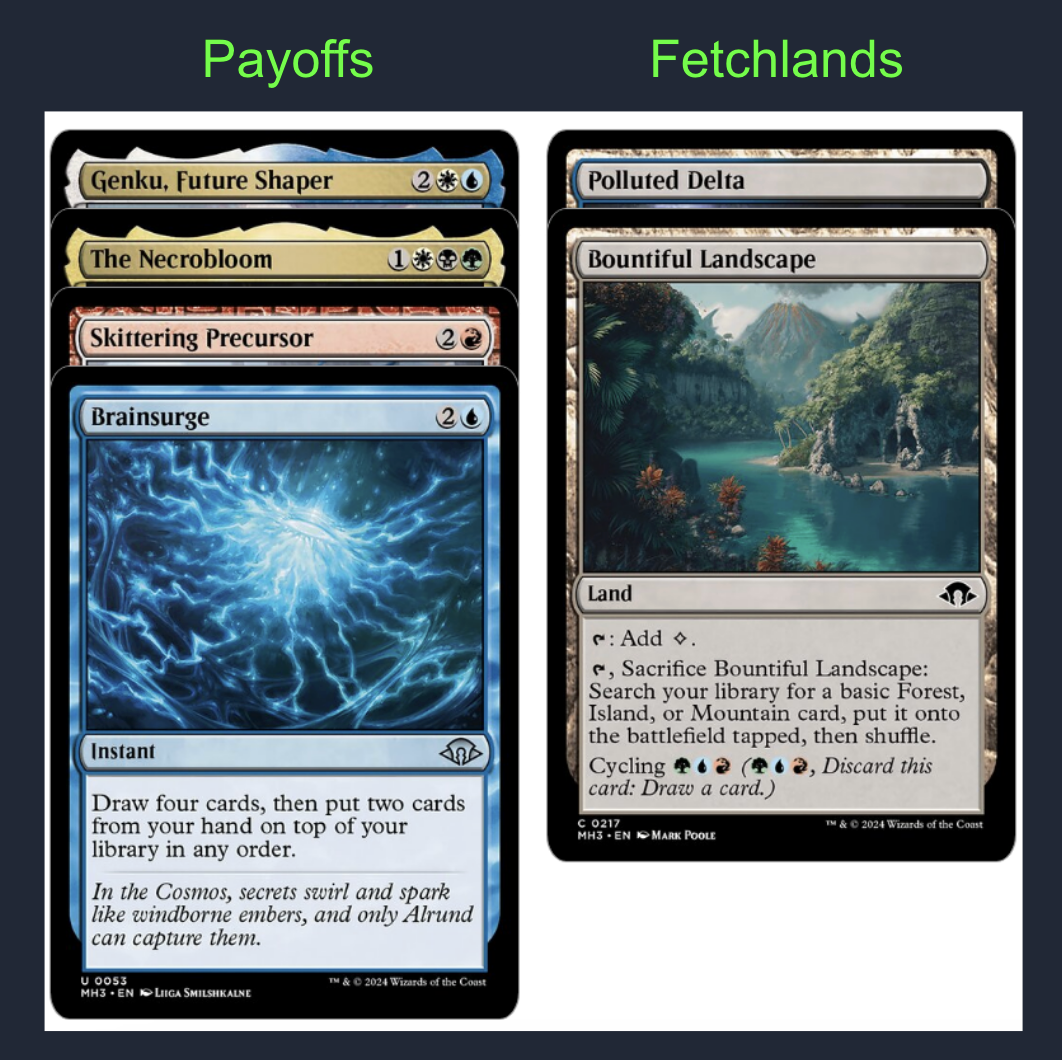
there are quite a few cards in the set that make you want to have as many fetchlands as you can get your hands on - with Genku especially fetchlands become one of the best hits
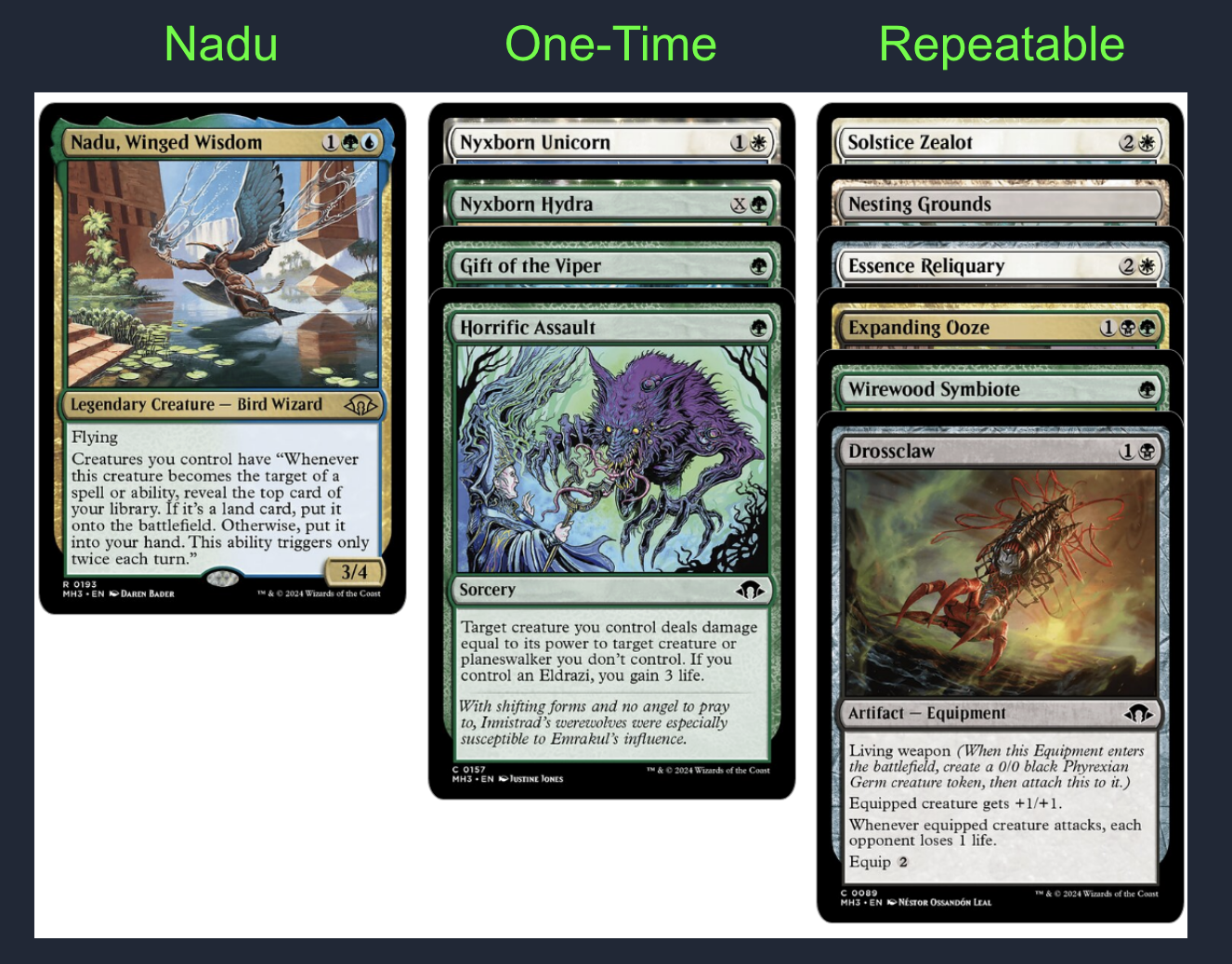
Nadu is good as just a 3 mana 3/4 flyer with protection, but it gets really strong when you have ways of targeting your own creatures, especially repeatably. Special shoutouts to Nesting Grounds as a land that targets twice, without needing any counters involved!
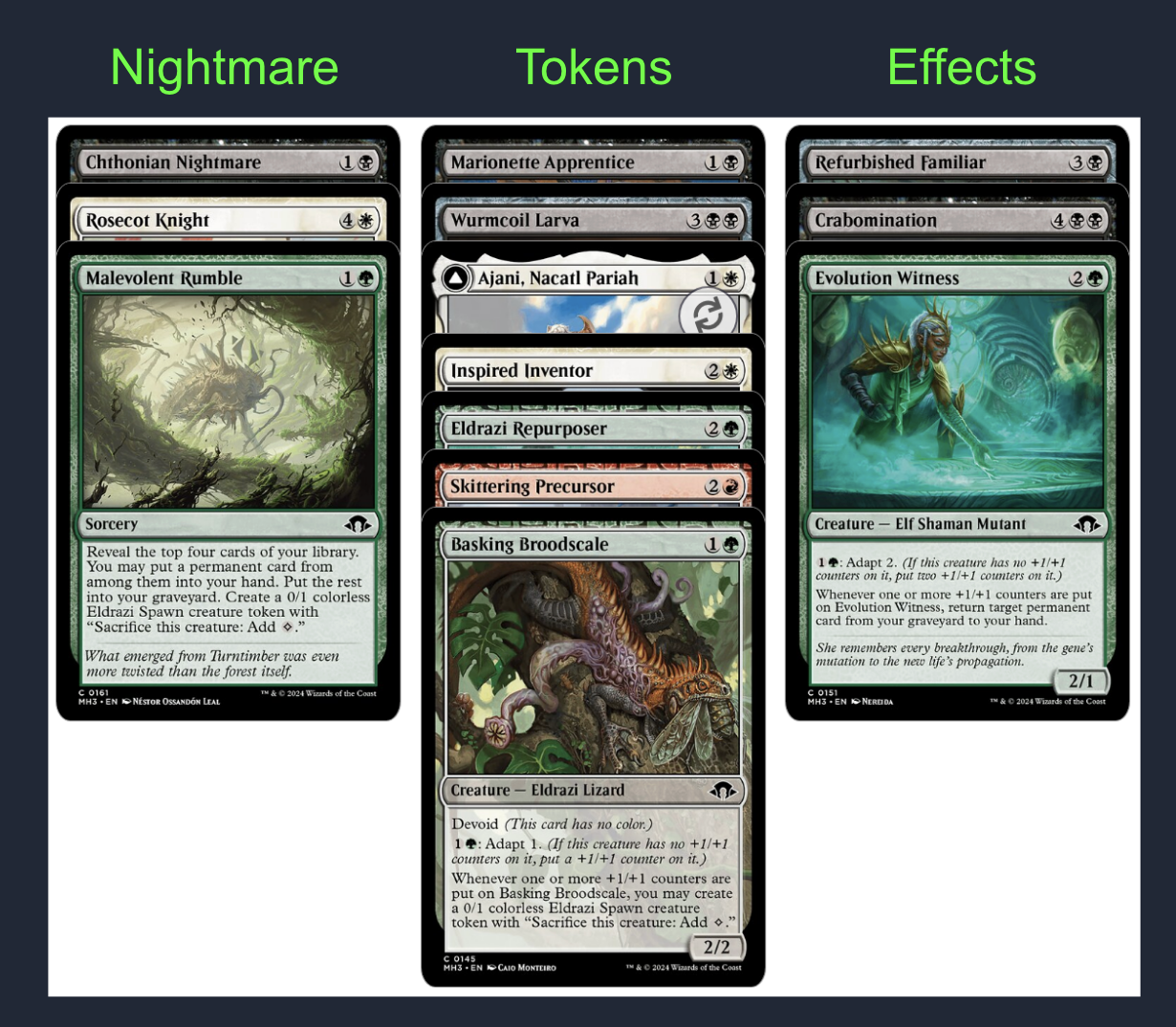
Nightmare is okay in any deck, but gets a lot better if you actually build around it. Token-makers are really nice for growing your board, and of course anything with a good ETB is nice to rebuy over and over
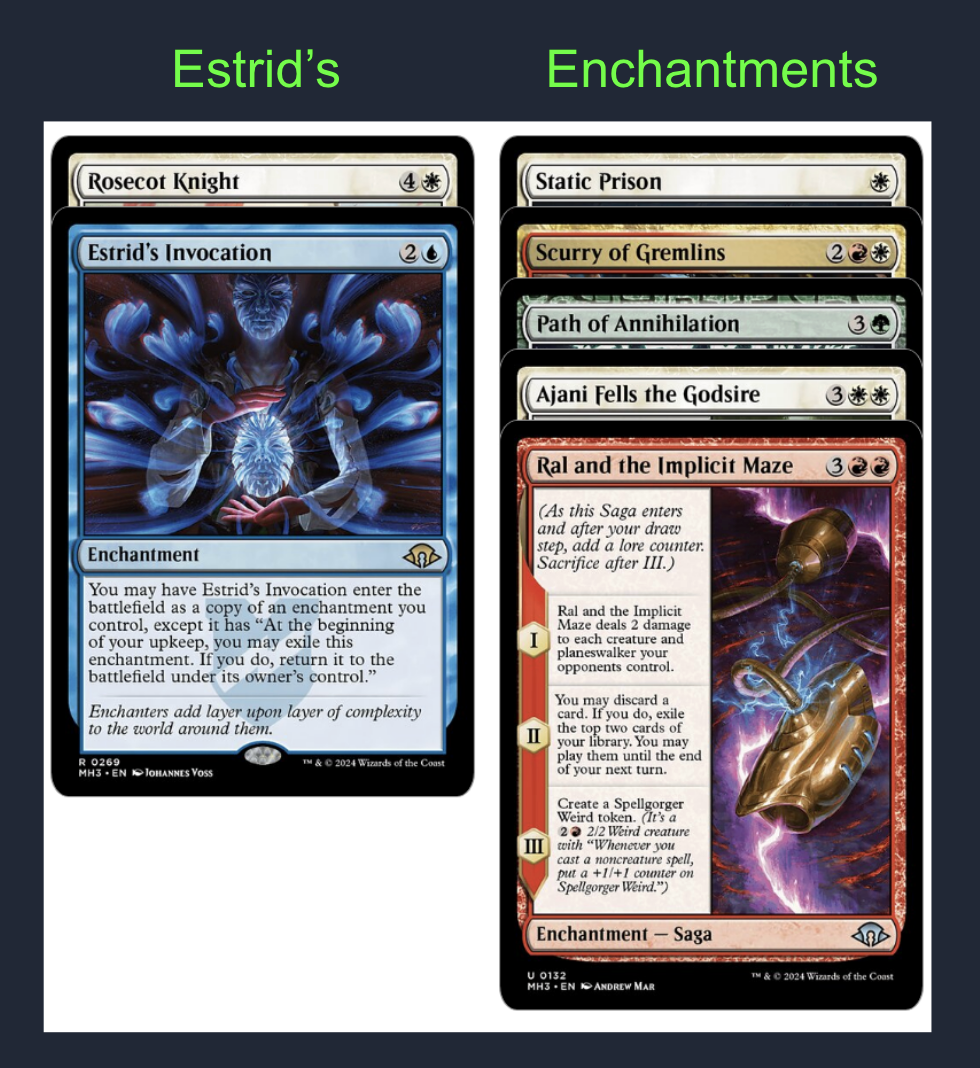
Estrid's Invocation is kind of a budget Essence Reliquary in that it only works with enchantments, but it's nice that the blink doesn't cost mana. It plus Scurry is an extremely strong combo, and there are more good targets besides
And, of course, for a deeper dive on the Essence Reliquary synergy space, check out my previous article!
#FreePalestine | Consider donating to UNWRA or PCRF, supporting protesters locally, and educating yourself.
